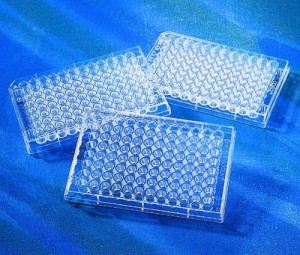96-Well Clear Polystyrene Microplates, Corning®
By Corning®
These clear, polystyrene 96-well plates from Corning® are available with round, flat, or V-bottom (conical) wells. Plate dimensions (length x width x height) of 127.76 x 85.48 x 14.22mm. Footprint meets microplates industry standards. Available in sterile or non-sterile; with or without lids and bagged or individually wrapped.
Cat.Nos. 83-3798 and 83-3898 are Special Process plates which are processed to improve hydrophilicity for hemaglutination and similar assays. Cat.No. 83-9017 are EIA/RIA plates which are tested on lot-to-lot basis and the certification results for each lot are made available upon request.
Not treated (or medium binding) polystyrene surface is hydrophobic in nature and binds biomolecules through passive interactions. Is suitable primarily for the immobilization of large molecules, such as antibodies, that have large hydrophobic regions that can interact with the surface. Untreated microplates have a binding capacity of approximately 100 to 200ng IgG/cm2. High binding surface is capable of binding medium (>10kD) and large biomolecules that possess ionic groups and/or hydrophobic regions. Binding capacity is approximately 400 to 500ng IgG/cm2. Ideal for immunoassays.
Photo-reactive (Universal-BIND™) surface covalently immobilizes biomolecules via abstractable hydrogens using UV illumination, resulting in a carbon-carbon bond. Although linkage is nonspecific and does not allow for site-directed orientation of a biomolecule, this surface may be useful for immobilization of double stranded DNA, antigens of unknown structure, and mixtures of biomolecules (e.g., cell lysates). Carbohydrate (Carbo-BIND™) binding surface has hydrazide groups covalently coupled to carbohydrate groups. Ideal for assays requiring site-directed orientation of a biomolecule (oxidized antibodies, carbohydrates, and glycosylated proteins) while maintaining enzymatic or immunological activity. Sulfhydryl (Sulfhydryl-BIND™) binding surface has covalently-linked maleimide groups that covalently couple to sulfhydryl groups via SH moieties. Ideal for assays requiring site-directed orientation of a biomolecule, especially antibodies. Special process plates are processed to improve hydrophilicity for hemagglutination and similar assays.
